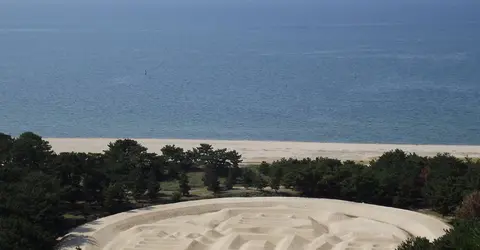Ibukijima Island 伊吹島
- Published on : 14/05/2019
- by : I.D.O.
- Youtube

View of Ibukijima
Dokudami, Wikimedia
An island like no other
Located 10 km off the west coast of Kagawa Prefecture, Ibukijima is the furthest inland and westernmost island of Shikoku Island. Ibukijima is a tiny island but it is the capital for the production of sardines and anchovies. Also known for its participation in the 2019 Setouchi Triennale.
A unique island in many ways
Its remoteness contributed to the development of a unique culture and dialect. The inhabitants of the island indeed speak a language very close to the Japanese spoken during the Heian period (794-1185), making this dialect a subject of linguistic studies.
Ibukijima also has a particular configuration: it is formed by an inclined plateau at the top of which the village, Ibukicho, was built, a small town with old-fashioned charm woven with narrow alleys. Here and there, abandoned houses or schools testify to the desertification of the place, despite its significant fishing activity. However, the village is home to a few Shinto temples and shrines, including the Ibuki Hachimangu shrine, located in the center of the island.
From the village, there are very beautiful views of the surroundings. A few old stalls and restaurants give it a semblance of life, the activity is downstairs, by the sea.
All along its coast, factories process and dry the sardines and anchovies caught nearby, making this islet of 1.05 km2 and 5.4 km in circumference, the leading producer of sardines and anchovies in Japan. . It is in particular with the dried fish of Ibuki that the famous niboshi dashi is made.
Ibukijima and the Setouchi Triennial
Ibukijima Island will be an exhibition venue for works from the Setouchi Triennale, a contemporary art festival held every three years in the Seto Inland Sea. With the fishing season in full swing from June to August, Ibukijima will only participate in the fall session, from September 28 to November 4. But in general, the works exhibited outdoors can be admired throughout the year. For the 2019 edition, Ibukijima will host works by Indonesian artist Eko Nugroho and Japanese Takashi Kuribayashi.
Works accessible all year round:
House of Toilets was created in 2013 by Japanese artist Daigo Ishii. As its name suggests, these workhouse public toilets! But what toilets!
Unsinkable Ship by Ryo Toyofuku and the Chiba Art School (2013). Installed in several rooms of a former primary school, this strange work is made up, among other things, of around 50,000 floats made by Ryo Toyofuku with the help of the Chiba School of Art and the inhabitants of Ibukijima and Kanonji. Floats, ropes, nets, a completely crazy allegory of the sea.
Iriko Retreat (the dried sardine refuge). This shelter was partly built with trays on which the sardines are put to dry. There are architectural elements specific to the island: the tiled roof, the eaves, and the stone walls. This work was created in 2016 by the Mikan group (Kiwako Kamo, Masashi Sogabe, Masayoshi Takeuchi, and Manuel Tardits) and students from Meiji University.
Legend of Ibuki Island Drift: Video game created in 2016 by Contact Gonzo: a virtual way to cross the alleys of the island on a scooter.
To learn more about the Setouchi Triennale and its region:
- The Seto Inland Sea
- How to get around during the Setouchi Triennale?
- The Shimanami Kaido Cycle Path
- Teshima Island
- Honjima Island
- Ibukijima Island
- Awashima Island
- Shamijima Island
- Takamijima Island
- Ogijima Island
- Megijima Island
- Takamatsu City
- Uno Harbor
- Kosan-ji Temple
- The Myths of the Seto Inland Sea Islands
- Battles and legends in the Seto Inland Sea
- Pirates and Fighters of the Seto Inland Sea
- Youkai of the Seto Inland Sea
- Naoshima's open-air works of art
Address, timetable & access
Address
Timetable
Take a boat from Kanonji port (four per day, 25 min). The port is connected to Kanonji Station by bus (one every 2 hrs, 10 min ride). You can also get there on foot (about 20 min walk). During the Setouchi Triennale, there will be 6 ferries a day (about one every 2-3 hrs).















